
Inverness & Loch Ness at a Glance
INVERNESS & LOCH NESS IN 1 DAY
Map: Pitlochry & Balmoral Castle Area
Inverness, the Highlands’ de facto capital, is an almost unavoidable stop on the Scottish tourist circuit. It’s a pleasant town and an ideal springboard for some of the country’s most famous sights. Hear the music of the Highlands in Inverness and the echo of muskets at Culloden, where government troops drove Bonnie Prince Charlie into exile and conquered his Jacobite supporters. Just to the southwest of Inverness, explore the locks and lochs of the Caledonian Canal while playing hide-and-seek with the Loch Ness monster.
Though it has little in the way of sights, Inverness is a handy spot to spend a night or two between other Highland destinations. With two nights, you can easily find a full day’s worth of sightseeing nearby: Choose among Loch Ness sights, the Culloden Battlefield, or a Highlands bus tour.
For evening fun, take your pick of live music, pub grub, whisky tastings, fine dining, and a riverside stroll.
Rick’s Tip: Drivers heading between Oban and Inverness can see the Loch Ness sights en route, rather than as a side-trip from Inverness.
Inverness is situated on the River Ness at the base of a castle (now used as a courthouse, but with a public viewpoint). Inverness’ charm is its normalcy—it’s a nice, midsize Scottish city that gives you a palatable taste of the “urban” Highlands and a contrast to cutesy tourist towns. It has a disheveled, ruddy-cheeked grittiness and is well located for enjoying the surrounding countryside sights. Check out the bustling, pedestrianized downtown, or meander the picnic-friendly riverside paths and islands—best at sunset, when the light hits the castle and couples hold hands while strolling along the water and over its footbridges.
Inverness, with about 70,000 people, has been one of the fastest-growing areas of Scotland in recent years. Marked by its castle, Inverness clusters along the River Ness. The TI is on High Street, an appealing pedestrian shopping zone a few blocks away from the river; nearby are the train and bus stations. Most of my recommended B&Bs huddle atop a gentle hill behind the castle (a 10-minute uphill walk from the city center).
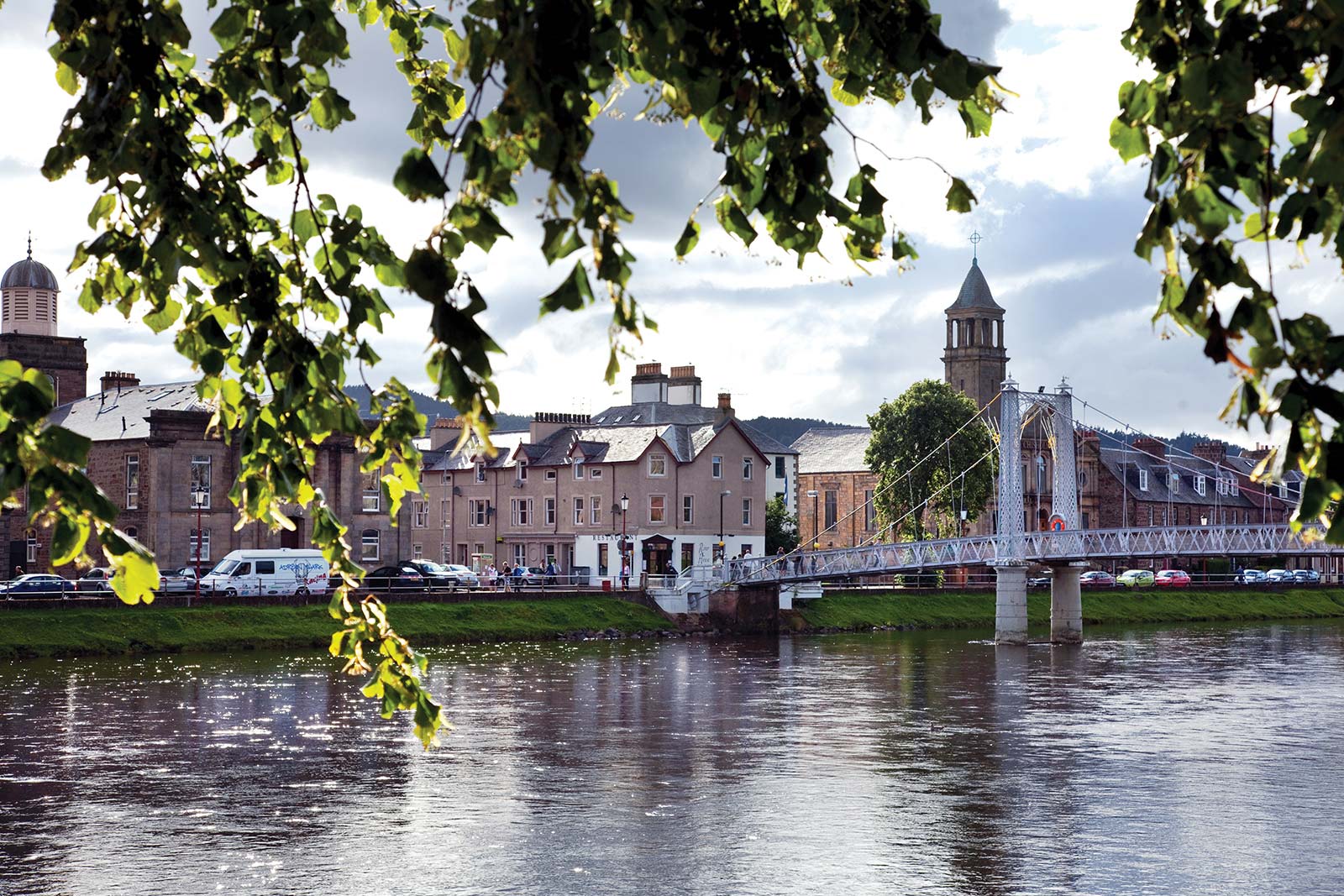
Inverness
Tourist Information: At the TI, you can pick up the self-guided City Centre Trail walking-tour leaflet and the What’s On weekly events sheet (June-Sept Mon-Sat 8:45-18:30, shorter hours on Sun and off-season, free Wi-Fi, 36 High Street, tel. 01463/252-401, www.inverness-scotland.com).
Festivals: The summer is busy with events. Book far ahead during these times, including the Etape Loch Ness bike race (early June), Highland Games (late June), Belladrum Tartan Heart Festival (music, late July), Black Isle farm show (early Aug), and Loch Ness Marathon (late Sept).
Bookstore: Leakey’s Bookshop, in a converted church built in 1649, is the place to browse through teetering towers of musty old books and vintage maps. Climb the spiral staircase to the loft for views over the stacks (Mon-Sat 10:00-17:30, closed Sun, Church Street, tel. 01463/239-947, Charles Leakey).
Baggage Storage: The train station has lockers (Mon-Sat 6:40-20:30, Sun from 10:40), or you can leave your bag at the bus station’s ticket desk (small fee, daily until 17:30).
Laundry: New City Launderette is near the west end of the Ness Bridge (self-service or same-day full-service, Mon-Sat 8:00-18:00, until 20:00 Mon-Fri in summer, Sun 10:00-16:00 year-round, 17 Young Street, tel. 01463/242-507). Thirty Degrees Laundry on Church Street is another option (full-service only, drop off before 10:00 for same-day service, Mon-Sat 8:30-17:30, closed Sun, a few blocks beyond Victorian Market at 84 Church Street, tel. 01463/710-380).
Hard-working Alison leads small groups on two-hour bike tours. Her six-mile route is nearly all on traffic-free paths along canals and lochs outside of the city and comes with light guiding along the way. You’ll pedal through Ness Island, stop at the Botanical Gardens, ride along the Caledonian Canal with its system of locks (you may even catch a boat passing through the locks), and cycle through a nature preserve (£21, no kids under 14, 10-person max; daily in season at 10:00, 13:00, and 16:00; best to book spot in advance online, goes even in light rain, meet near west end of Ness Bridge at Prime Restaurant at 5 Ness Walk, call or text mobile 07443-866-619, www.invernessbiketours.co.uk, info@invernessbiketours.co.uk). Arrive a bit early to size up your bike and helmet.
While thin on sights of its own, Inverness is a great home base for day trips. A variety of tour companies offer day trips—details and tickets are available at the TI. While the big sellers among Inverness day-trips are the many Loch Ness tours (because the monster is on every bucket list), I far prefer an Isle of Skye all-day joyride—which gives you a good look at Loch Ness and its famous castle along the way. Study the various websites for comparative details. For Isle of Skye tours in summer, it’s a good idea to book about a week in advance.
The famous lake is just a 20-minute drive from Inverness. Tours will often include a short boat ride, a visit to Urquhart Castle, and a stop at the Loch Ness monster exhibits. The lake is not particularly scenic. The castle, while scenic, is just a shell. And the monster is mostly a promotional gimmick. Still, if you have no car, this can be the most efficient way to check this off your list. Jacobite Tours focuses on trips that include Loch Ness, from a one-hour basic boat ride to a 6.5-hour extravaganza. Their four-hour “Sensation” tour includes a guided bus tour with live narration, a half-hour Loch Ness cruise, and visits to Urquhart Castle and the Loch Ness exhibits (£35, www.jacobite.co.uk, tel. 01463/233-999).
Several companies do good day tours to the Isle of Skye. They travel 110 miles (a 2.5-hour drive) to the heart of Skye (Portree). With about six hours of driving, and one hour for lunch in Portree, that leaves two or three hours for a handful of quick and scenic photo stops. All travel along Loch Ness so you can see Urquhart Castle and try for a monster sighting. And all stop for a view of Eilean Donan Castle. The longer rides loop around the Trotternish Peninsula.
Wow Scotland’s ambitious 12-hour itinerary goes in a big bus. They depart at 8:30 from the Inverness bus station and include short but smart and adequate stops all along the way (£77, 5/week June-Aug, fewer departures in April-May and Sept, none Oct-March, tel. 01808/511-773, www.wowscotlandtours.com). I’d pay the extra for the £99 front row.
Highland Experience Tours runs another, shorter Isle of Skye itinerary in 24-seat buses (daily April-Oct, less off-season, 10 hours) but doesn’t make it as far north as the Trotternish Peninsula (£55, tel. 01463/719-222, www.highlandexperience.com). They offer a variety of other daylong tours, including to the far north with John O’Groats, or a trip to Royal Deeside and the Speyside Whisky Trail.
Happy Tours Scotland organizes daily minibus tours on a 10-hour joy ride (getting all the way to Quiraing) with top-notch guides (£70, 8 people per minibus, daily at 8:30, leaves from 7 Ness Walk at Columba Hotel, mobile 07828-154-683, book at www.happy-tours.biz, run by Cameron). They also do other tours including itineraries focusing on Loch Ness, the Outlander books and TV series, a Speyside whisky tour, and private minibus tours.
Rabbie’s Small Group Tours does 12-hour trips to Skye in its 16-seater buses for £52 nearly daily from Inverness. Their website explains their busy program (www.rabbies.com).
Iona Highland Tours takes eight people on several different Isle of Skye itineraries, including one that allows hiking time at the Fairy Pools (£70, 9 hours, tel. 01463/250-457, www.ionahighlandtours.com).
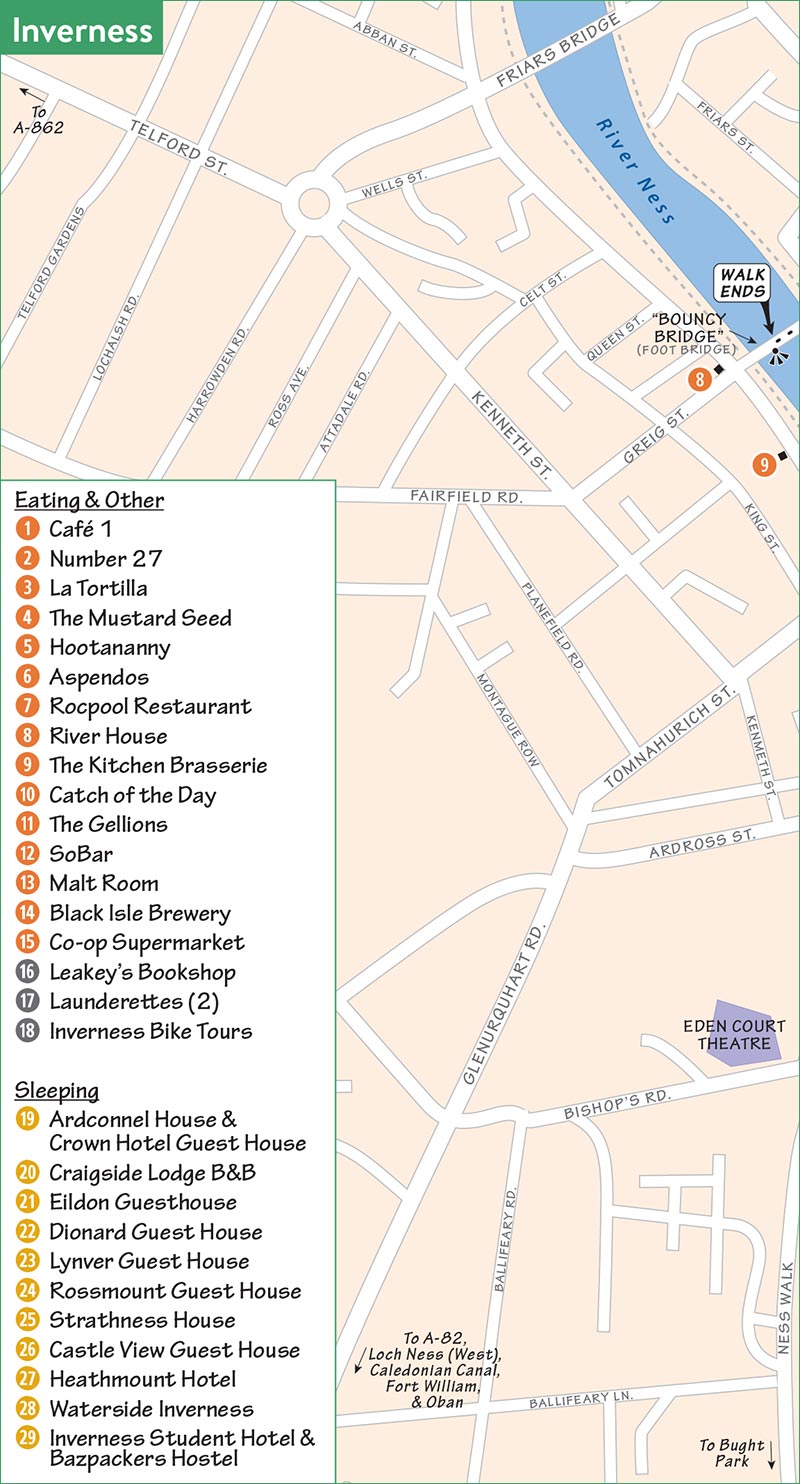
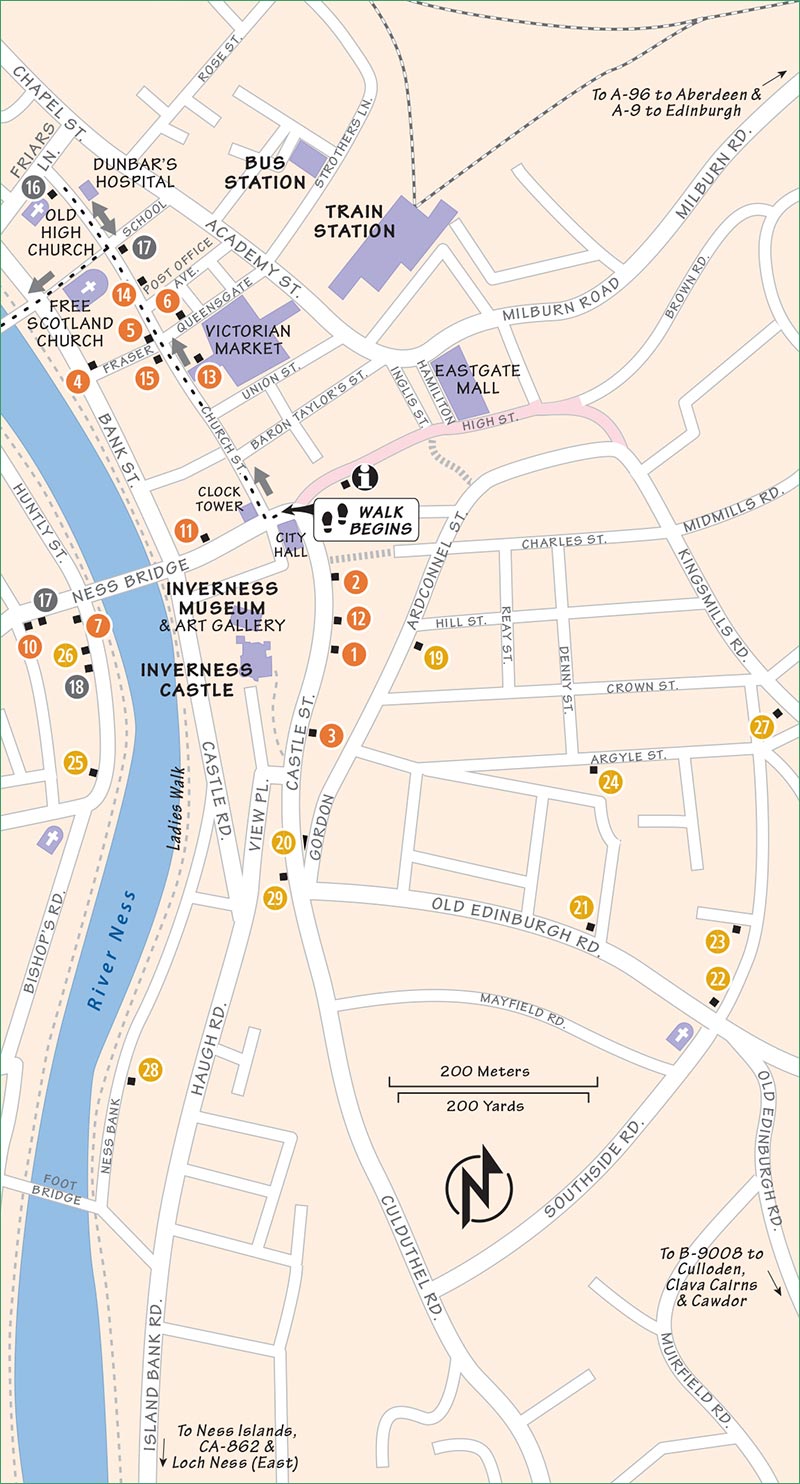

By Train Then Tour: To avoid a long bus ride or skip the sights along the way to Skye, take the train from Inverness to Kyle of Lochalsh, where a Skye-based tour company will pick you up and take you around. Try Skye Tours (tel. 01471/822-716, www.skye-tours.co.uk) or Tour Skye (tel. 01478/613-514, www.tourskye.com). The train leaves Inverness before 9:00 and arrives around 11:30; the return train is around 17:15 (covered by BritRail Pass).
For a very ambitious itinerary, John O’Groats Ferries offers an all-day tour that departs Inverness at 7:15, drives you up to John O’Groats to catch the 40-minute passenger ferry, then a second bus takes you on a whistle-stop tour of Orkney’s main attractions (with an hour in the town of Kirkwall) before returning you to Inverness by 21:00. While it’s a long day, it’s an efficient use of your time if you’re determined to see Orkney (£74, daily June-Aug only, tel. 01955/611-353, www.jogferry.co.uk).
Humble Inverness has meager conventional sights, but its fun history and quirky charm become clear as you take this short self-guided walk.
• Start at the clock tower.
Clock Tower: The tower looming 130 feet above you is all that remains of a tollbooth building erected in 1791. This is the highest spire in town. Here, four streets—Church, Castle, Bridge, and High—come together, integrating God, defense, and trade—everything necessary for a fine city.
About 800 years ago, a castle was built on the bluff overhead and the town of Inverness coalesced right about here. For centuries, this backwater town’s economy was based on cottage industries. Artisans who made things also sold them. In 1854, the train arrived, injecting energy and money from Edinburgh and Glasgow, and the Victorian boom hit. With the Industrial Age came wholesalers, distributors, mass production, and affluence. Much of the city was built during this era, in Neo-Gothic style—over-the-top and fanciful, like the City Hall (from 1882, kitty-corner to the clock tower). With the Victorian Age also came tourism.
Look for the Bible quotes chiseled into the wall across the street from the City Hall. A civic leader, tired of his council members being drunkards, edited these Bible verses for maximum impact, especially the bottom two.
Hiding just up the hill (behind the eyesore concrete home of the Inverness Museum and Art Gallery) is Inverness Castle. While the “castle” is now a courthouse, there is a small exhibition and a chance to climb to the top of the tower (£5).
Rick’s Tip: It’s worth hiking up to the castle at some point during your visit to enjoy some of the best views of Inverness and its river.
• Walk a few steps away from the river (toward McDonald’s)...
Mercat Cross and Old Town Center: Standing in front of the City Hall is a well-worn mercat cross, which designated the market in centuries past. This is where the townspeople gathered to hear important proclamations, share news, watch hangings, gossip, and so on.
The yellow Caledonian building faces McDonald’s at the base of High Street. (Caledonia was the ancient Roman name for Scotland.) It was built in 1847, complete with Corinthian columns and a Greek-style pediment, as the leading bank in town. Notice how nicely pedestrianized High Street welcomes people and seagulls...but not cars.
• Next we’ll head up Church Street, which begins between the clock tower and The Caledonian.
Church Street: The street art you’ll trip over at the start of Church Street is called Earthquake—a reminder of the quake that hit Inverness in 1816. As the slabs explain, the town’s motto is “Open Heartedness, Insight, and Perseverance.”
Stroll down Church Street. Look up above the modern storefronts to see Old World facades. Union Street (the second corner on the right)—stately, symmetrical, and Neoclassical—was the fanciest street in the Highlands when it was built in the 19th century. Its buildings had indoor toilets. That was big news.
Midway down the next block of Church Street (on the right), an alley marked by an ugly white canopy leads to the Victorian Market. Venturing down the alley, you’ll pass The Malt Room (a recommended small, friendly whisky bar eager to teach you to appreciate Scotland’s national tipple) and The Old Market Bar (a dive bar worth a peek). Stepping into the Victorian Market, you’ll find a gallery of shops under an iron-and-glass domed roof dating from 1876. The first section seems abandoned, but delve deeper to find more active areas, where local shops mix with tacky “tartan tat” souvenir stands. If you’re seriously into bagpipes, look for Cabar Fèidh, where American expat Brian sells CDs and sheet music, and repairs and maintains the precious instruments of local musicians.
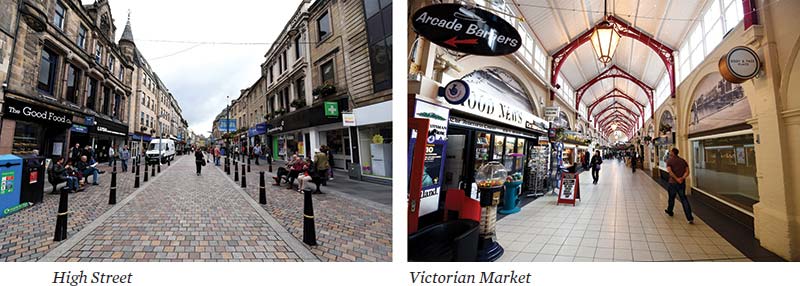
Go back out of the market the way you came in, and continue down Church Street. At the next corner you come to Hootananny, famous locally for its live music (pop in to see what’s on tonight). Just past that is Abertarff House, the oldest house in Inverness. It was the talk of the town in 1593 for its “turnpike” (spiral staircase) connecting the floors.
Continue about a block farther along Church Street. The lane on the left leads to the “Bouncy Bridge” (where we’ll finish this walk). Opposite that lane (on the right) is Dunbar’s Hospital, with four-foot-thick walls. In 1668, Alexander Dunbar was a wealthy landowner who built this as a poor folks’ home.
A few steps farther up Church Street, walk through the iron gate on the left and into the churchyard (we’re focusing on the shorter church on the right—ignore the bigger one on the left). Looking at the WWI and WWII memorials on the church’s wall, it’s clear which war hit Scotland harder. While no one famous is buried here, many tombstones go back to the 1700s. Being careful not to step on a rabbit, head for the bluff overlooking the river and turn around to see...
Old High Church: There are a lot of churches in Inverness (46 Protestant, 2 Catholic, 2 Gaelic-language, and one offering a Mass in Polish), but these days, most are used for other purposes. This one, dating from the 11th century, is the most historic (but is generally closed).
In the sixth century, the Irish evangelist monk St. Columba brought Christianity to northern England, the Scottish islands (at Iona), and the Scottish Highlands (in Inverness). He stood here amongst the pagans and preached to King Brude and the Picts.
Study the bell tower from the 1600s. The small door to nowhere (one floor up) indicates that back before the castle offered protection, this tower was the place of last refuge for townsfolk under attack. They’d gather inside and pull up the ladder. The church became a prison for Jacobites after the Battle of Culloden, and executions were carried out in the churchyard.
Every night at 20:00, the bell in the tower rings 100 times. It has rung like this since 1730 to remind townsfolk that it’s dangerous to be out after dinner.
• From here, you can circle back to the lane leading to the “Bouncy Bridge” and then hike out onto the bridge. Or you can just survey the countryside from this bluff.
The River Ness: Emptying out of Loch Ness and flowing seven miles to the sea (a mile from here), this is one of the shortest rivers in the country. While it’s shallow (you can almost walk across it), there are plenty of fish in it. In the 19th century, Inverness was smaller, and across the river stretched nothing but open fields. Then, with the Victorian boom, the suspension footbridge (a.k.a. “Bouncy Bridge”) was built in 1881 to connect new construction across the river with the town.
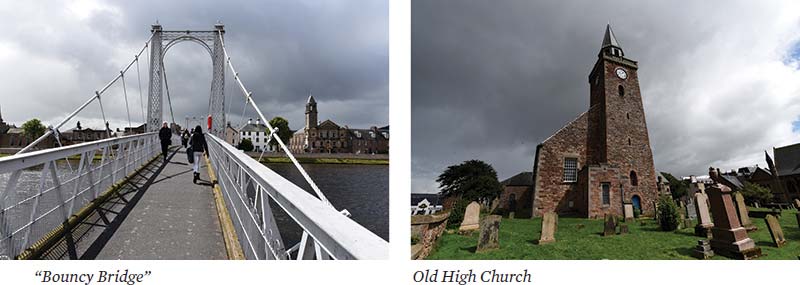
• Your tour is over.
INVERNESS MUSEUM AND ART GALLERY
This free, likable town museum is worth poking around on a rainy day to get a taste of Inverness and the Highlands. The ground-floor exhibits on geology and archaeology peel back the layers of Highland history: Bronze and Iron ages, Picts (including carved stones), Scots, Vikings, and Normans. Upstairs you’ll find the “social history” exhibit (everything from Scottish nationalism to hunting and fishing) and temporary art exhibits.
Cost and Hours: Free, April-Oct Tue-Sat 10:00-17:00, shorter hours off-season, closed Sun-Mon year-round, cheap café, in ugly modern building on the way up to the castle, tel. 01463/237-114, www.highlifehighland.com.
Aside from nice views from the front lawn, a small exhibit on the ground floor, and a tower climb (£5 for a commanding city view), Inverness’ biggest nonsight is not open to the public.
In 1715, the 15th-century castle that stood here was named Fort George by the English to demonstrate its control over the area. In 1745, it was destroyed by Bonnie Prince Charlie’s Jacobite army and remained a ruin until the 1830s, when the present castle was built. The statue outside (from 1899) depicts Flora MacDonald, who helped Bonnie Prince Charlie escape from the English.
Culloden can be reached by car or bus, but the other sights (Clava Cairns, Cawdor Castle, and the Leault sheepdog demonstration) are only doable by car.
Jacobite troops under Bonnie Prince Charlie were defeated at Culloden (kuh-LAW-dehn) by supporters of the Hanover dynasty (King George II’s family) in 1746. This last major land battle fought on British soil spelled the end of Jacobite resistance and the beginning of the clan chiefs’ fall from power. Wandering the desolate, solemn battlefield, you sense that something terrible occurred here. Locals still bring white roses and speak of “The ’45” (as Bonnie Prince Charlie’s entire campaign is called) as if it just happened. Be sure to visit the high-tech visitor center. Allow two hours here.
Cost and Hours: £11, £5 guidebook, daily April-Oct 9:00-17:30, June-Aug until 18:00, Nov-Dec and Feb-March 10:00-16:00, closed Jan, café, tel. 01463/796-090, http://www.nts.org.uk/culloden.
Tours: The included audioguide leads you through both the exhibition and the battlefield. There are several free tours daily along with costumed events (see schedule posted at entry).
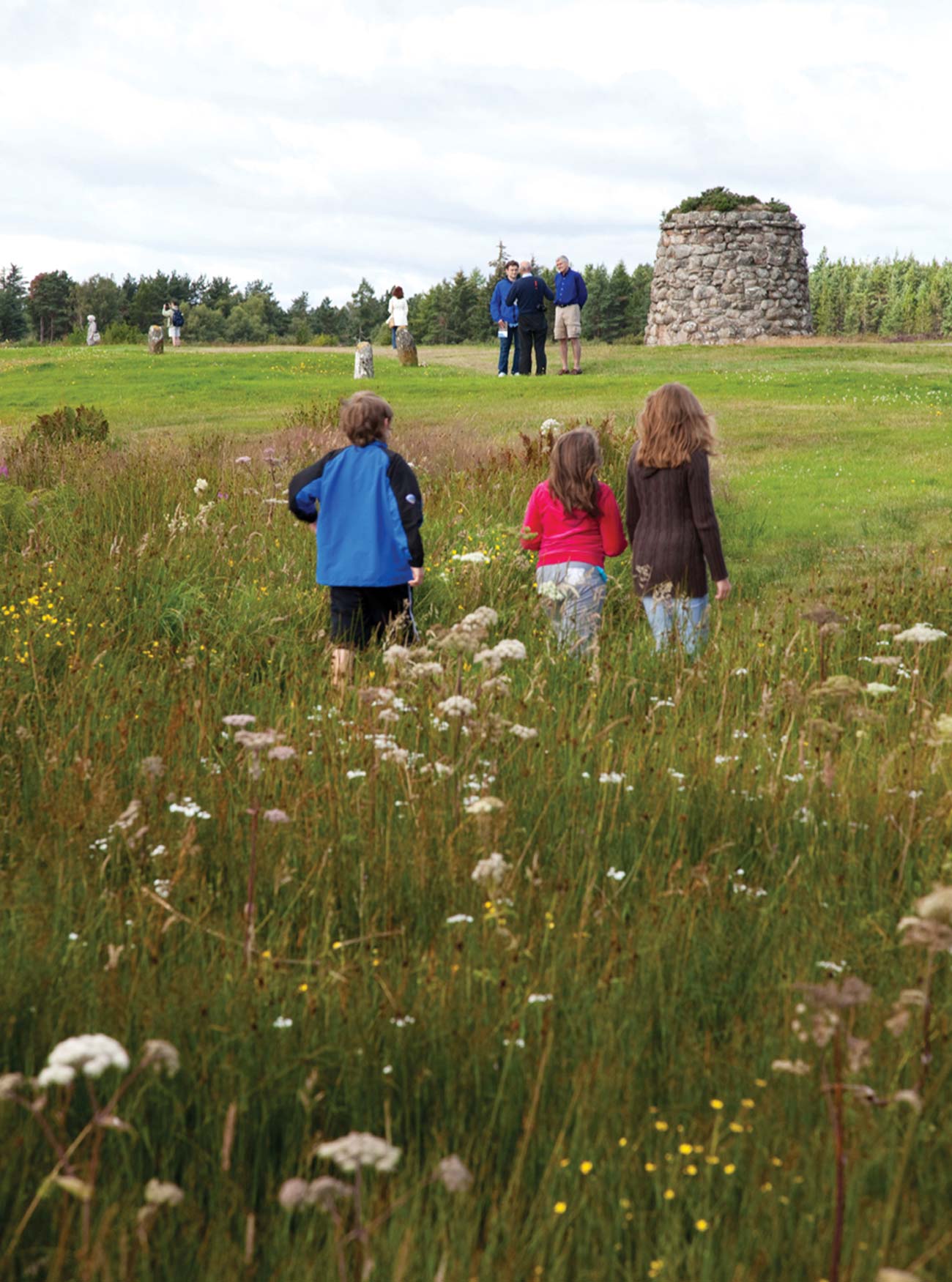
Culloden Battlefield
Getting There: It’s a 15-minute drive east of Inverness. Follow signs to Aberdeen, then Culloden Moor—the B-9006 takes you right there (well-signed on the right-hand side). Parking is £2. Public buses leave from Inverness’ Queensgate Street and drop you off in front of the entrance (£5 round-trip ticket, bus #5, roughly hourly, 40 minutes, ask at TI for route/schedule updates). A taxi costs around £15 one-way.
Background: Charles Edward Stuart (1720-1788) was raised with a single purpose—to restore his family to the British throne. His grandfather, King James II (VII of Scotland), was deposed in 1688 by the English Parliament for his tyranny and pro-Catholic bias. The Stuarts remained exiled in France until 1745, when young Charlie crossed the Channel to Scotland to rally support for the Jacobite cause and retake the throne.
The charismatic “Bonnie” (handsome) Charlie led an army of 2,000 tartan-wearing Highlanders across Scotland, seizing Edinburgh. They picked up other supporters from the Lowlands and from England. Now 6,000 strong, they marched south toward London—advancing as far as Derby, just 125 miles from the capital. But anticipated support for the Jacobites failed to materialize in the numbers they were hoping for (both in England and from France). The odds turned against them. Charles retreated to the Scottish Highlands, where many of his men knew the terrain and might gain an advantage when outnumbered. The English government troops followed closely on his heels.
Against the advice of his best military strategist, Charles’ army faced the Hanoverian forces at Culloden Moor on flat, barren terrain that was unsuited to the Highlanders’ guerrilla tactics. The Jacobites—many of them brandishing only broadswords, targes (wooden shields covered in leather and studs), and dirks (long daggers)—were mowed down by King George’s cannons and horsemen. In less than an hour, the government forces routed the Jacobite army.
Charles fled with a price on his head. He escaped to the Isle of Skye, hidden by a woman named Flora MacDonald. Flora dressed Charles in women’s clothes and passed him off as her maid.
Though usually depicted as a battle of the Scottish versus the English, in truth Culloden was a civil war between two opposing dynasties: Stuart (Charlie) and Hanover (George).
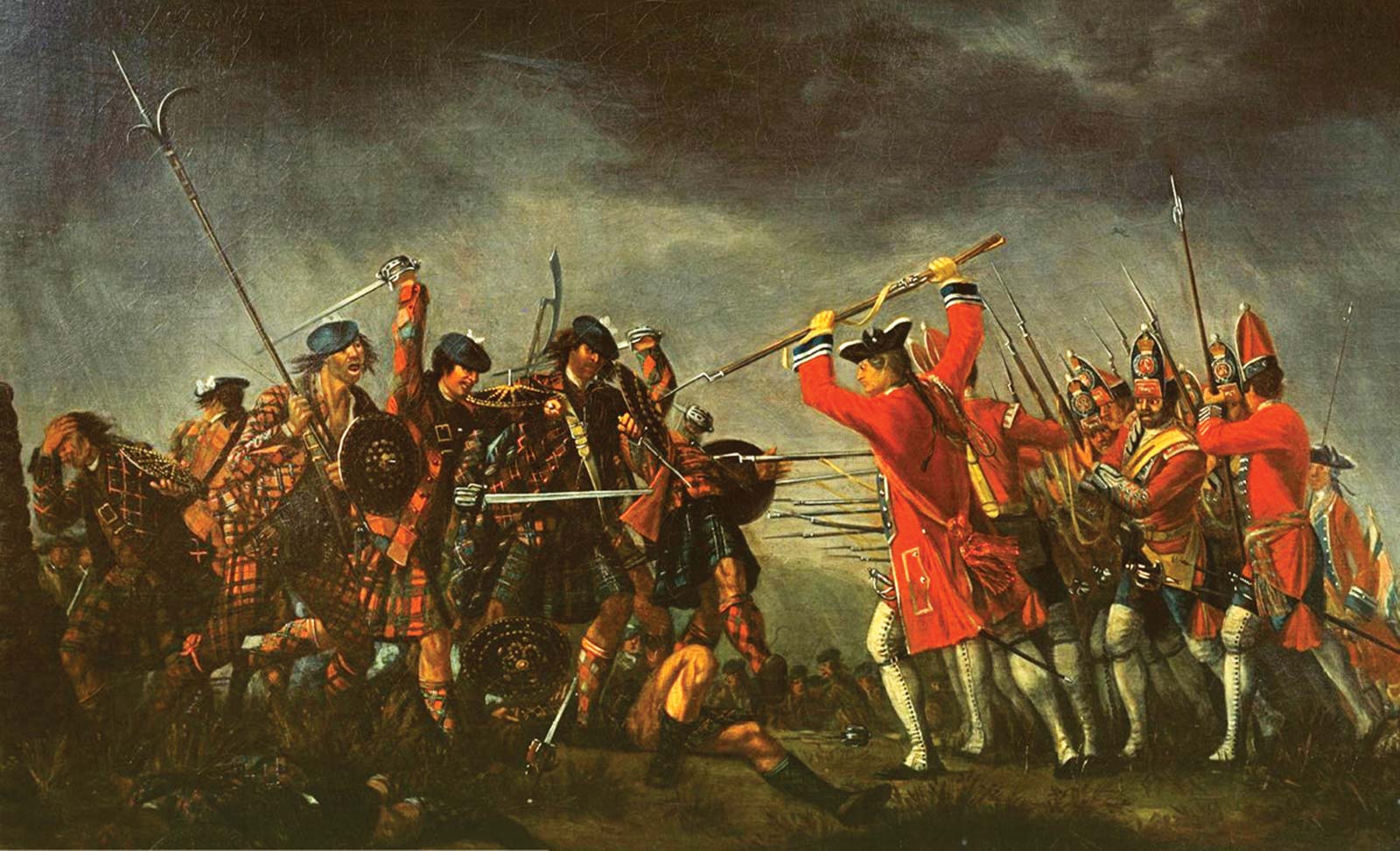
An Incident in the Rebellion of 1745 by David Morier
The Battle of Culloden was the end of 60 years of Jacobite rebellions and the final stand of the Highlanders. From then on, clan chiefs were deposed; kilts, tartans, and bagpipes were outlawed; and farmers were cleared off their ancestral land, replaced by more-profitable sheep. Scottish culture would never fully recover from the events of the campaign called “The ’45.”
 Self-Guided Tour: Your tour takes you through two sections: the exhibit and the battlefield.
Self-Guided Tour: Your tour takes you through two sections: the exhibit and the battlefield.
The Exhibit: As you pass the ticket desk, note the family tree: Bonnie Prince Charlie (“Charles Edward Stuart”) and George II were distant cousins. Then the exhibit’s shadowy-figure touchscreens connect you with historical figures who give you details from both the Hanoverian and Jacobite perspectives. A map shows the other power struggles happening in and around Europe, putting this fight for political control of Britain in a wider context. This battle was a key part of a larger struggle between Britain and its neighbors, primarily France, for control over trade and colonial power.
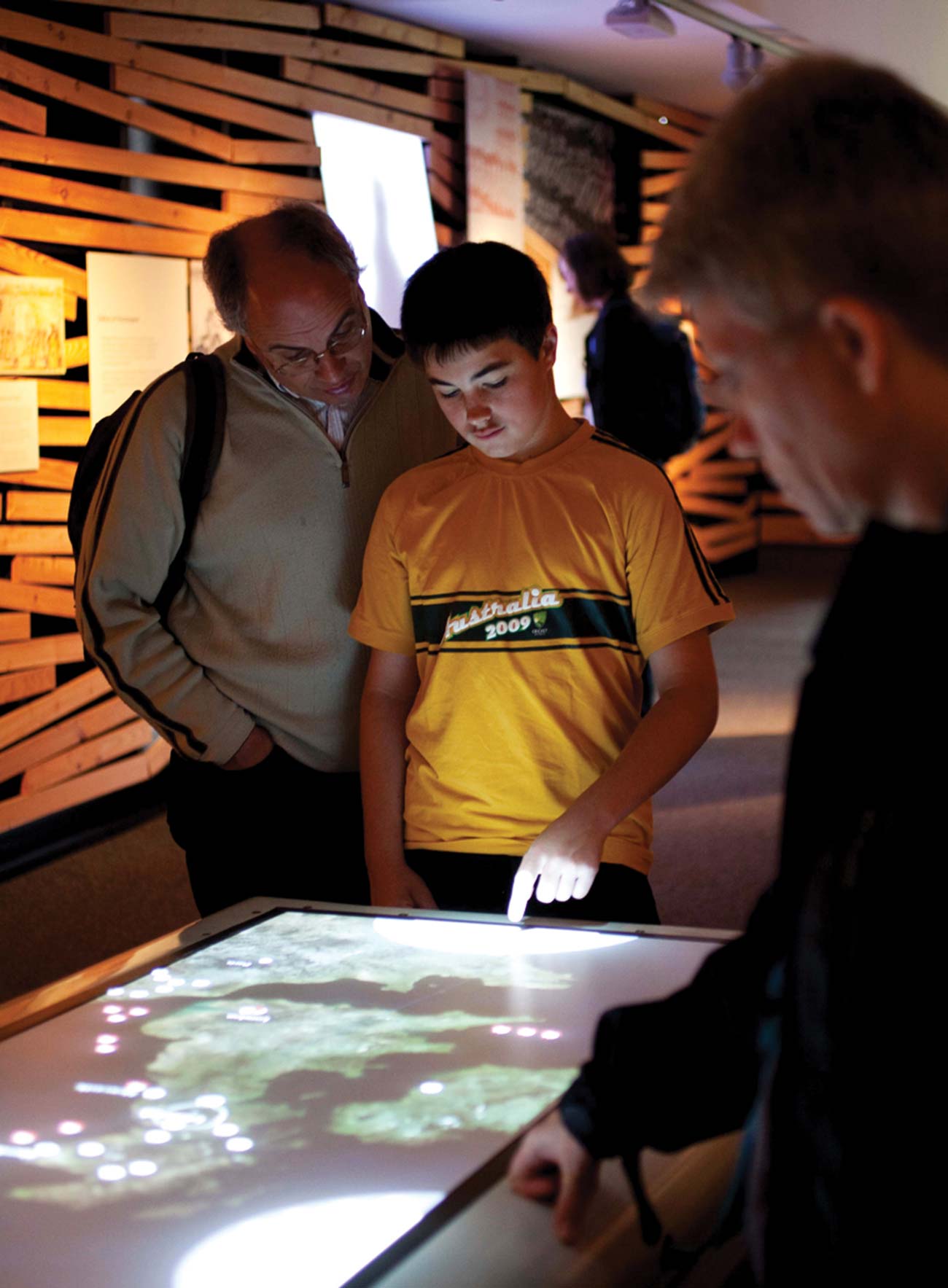
Culloden’s visitor center
From here, your path through this building is cleverly designed to echo the course of the Jacobite army. Your short march (with lots of historic artifacts) gets under way as Charlie sails from France to Scotland, then finagles the support of Highland clan chiefs. As he heads south with his army to take London, you, too, are walking south. Along the way, maps show the movement of troops, and wall panels cover the buildup to the attack. Note the clever division of information: To the left and in red is the story of the “government” (a.k.a. Hanoverians/Whigs/English, led by the Duke of Cumberland); to the right, in blue, is the Jacobites’ perspective (Prince Charlie and his Highlander/French supporters).
But you, like Charlie, don’t make it to London—in the dark room at the end, you can hear Jacobite commanders arguing over whether to retreat back to Scotland. Pessimistic about their chances of receiving more French support, they decide to U-turn, and so do you.
By the time you reach the end of the hall, it’s the night before the battle. Round another bend into a dark passage, and listen to the voices of the anxious troops. While the English slept soundly in their tents (recovering from celebrating the Duke’s 25th birthday), the scrappy and exhausted Jacobite Highlanders struggled through the night to reach the battlefield.
At last the two sides meet. As you wait outside the theater for the next showing, study the chart depicting how the forces were arranged on the battlefield. Once inside the theater, you’ll soon be surrounded by the views and sounds of a windswept moor. An impressive four-minute 360° movie projects the re-enacted battle with you right in the center of the action. The movie drives home just how outmatched the Jacobites were.
The last room has period weapons, including ammunition and artifacts found on the battlefield, as well as historical depictions of the battle. Be sure to tour the aftermath corridor and examine the huge map, giving you a bird’s-eye view of the field through which you’re about to roam.
The Battlefield: Leaving the visitors center, survey the battlefield (which you’ll tour with the help of your audioguide). In the foreground is a cottage used as a makeshift hospital during the conflict. Red flags show the front line of the government army (8,000 troops). This is where most of the hand-to-hand fighting took place. The blue flags in the distance are where the Jacobite army (5,500 troops) lined up.
As you explore the battlefield, notice how uneven and boggy the ground is in parts, and imagine trying to run across this hummocky terrain with all your gear, toward almost-certain death.
The old stone memorial cairn, erected in 1881, commemorates the roughly 1,500 Jacobites buried in in this field. It’s known as the Graves of the Clans. As you wander the battlefield, following the audioguide, you’ll pass by other mass graves, marked by small headstones, and ponder how entire clans fought, died, and were buried here.
These well-preserved Neolithic burial chambers are nestled in the countryside just beyond the Culloden Battlefield. Dating from 3,000 to 4,000 years ago, they appear to be just some giant piles of rocks in a sparsely forested clearing, but the info plaque near the entry explains the site. There are three structures: a “ring cairn” with a central (and inaccessible) open space, flanked by two “passage cairns.” The entrance shaft in each passage cairn lines up with the setting sun at the winter solstice. Each cairn is surrounded by a stone circle, and it’s all framed by evocative trees.
Cost and Hours: Free, always open; just after passing Culloden Battlefield on the B-9006 coming from Inverness, signs point to Clava Cairns; follow twisty road a couple miles, over “weak bridge” to site.
This is the beautiful, homey residence of the Dowager Countess of Cawdor, an aristocratic branch of the Campbell family. You’ll follow a one-way circuit around the castle with each room well-described with posted explanations (written by the countess’ late husband, the sixth Earl of Cawdor). Docents are happy to answer questions. The gardens are worth strolling. The small, nine-hole golf course on the grounds provides a quick, affordable way to have a Scottish golfing experience (£18/person with clubs; £4 for putting green only).
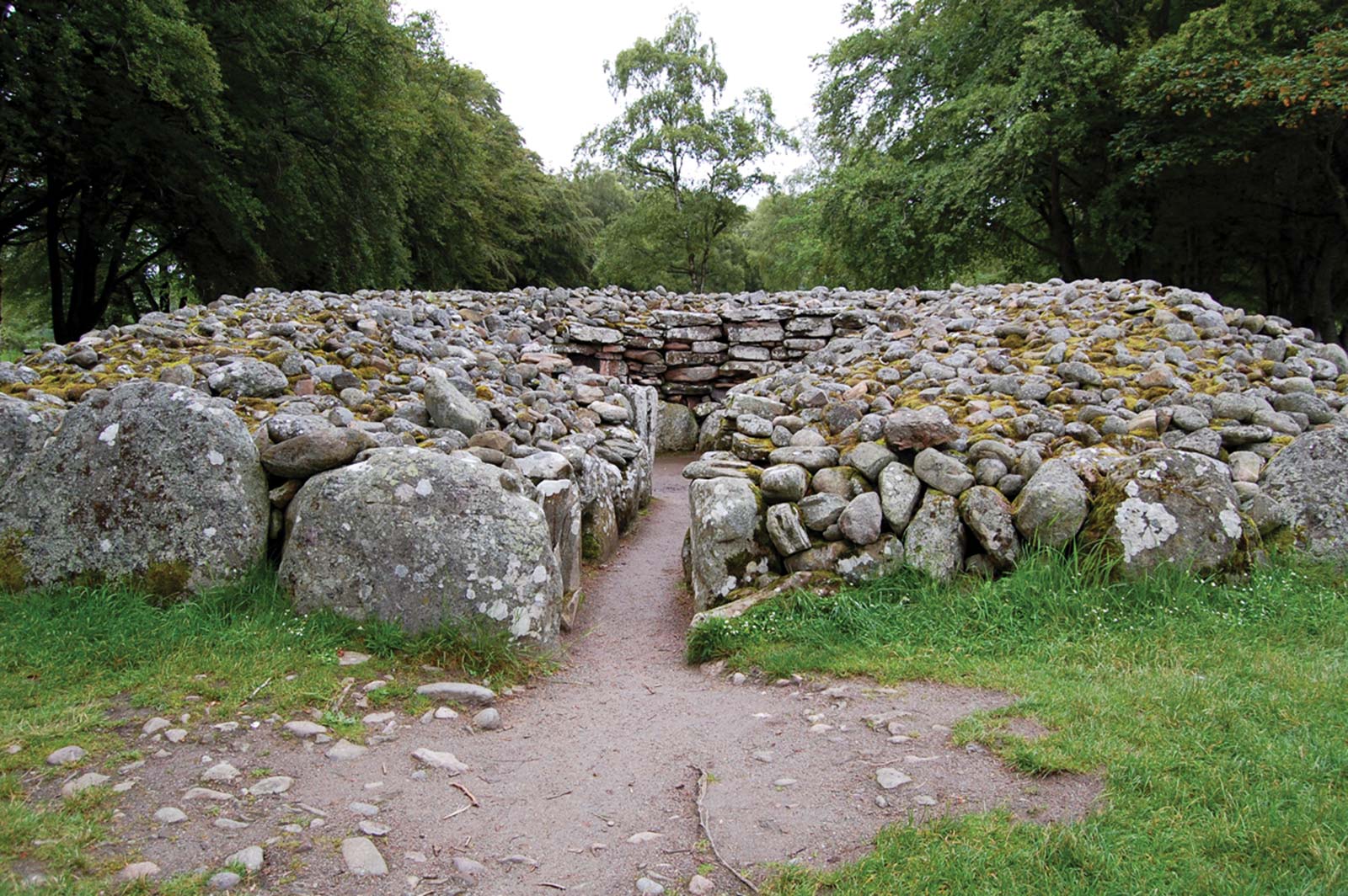
Clava Cairns
Cost and Hours: £11, good £5 guidebook; just off the A-96, 15 miles east of Inverness, and 6 miles beyond Culloden and Clava Cairns, May-Sept daily 10:00-17:30, closed Oct-April, www.cawdorcastle.com.
Every afternoon (except Sat), Neil Ross presents a 45-minute, fascinating demonstration of his well-trained sheepdogs. You’ll hunker down in a natural little amphitheater in the turf while Neil describes his work. Then the dogs get to work: With shouts and whistles, each dog follows commands, showing an impressive mastery over the sheep. Afterward, you’ll meet (and pet) the border collie stars of the show, and may have the chance to feed lambs or try shearing sheep.
Cost and Hours: £5; open only for one demonstration per day: May-Oct Sun-Fri at 16:00, closed Sat and Nov-April; exit A-9 at Kincraig, follow brown signs across A-9 to farm, tel. 01540/651-402, www.leaultworkingsheepdogs.co.uk.
Consider an early-morning stroll in Inverness along the Ness Bank to capture the castle at sunrise, or a postdinner jaunt to Bught Park for a local shinty match. The path is lit at night. The forested islands in the middle of the River Ness—about a 10-minute walk south of the center—are a popular escape from the otherwise busy city.
Rick’s Tip: For a Highland treat, catch a shinty match, a combination of field hockey, hurling, and American football—but without pads. Ask the TI if any matches are on at Bught Park, or search online for Inverness Shinty Club.
Past the islands, it’s not as idyllic or as pedestrian-friendly, but in this zone you’ll find minigolf, the free Botanic Gardens (daily 10:00-17:00, until 16:00 Nov-March), and the huge Active Inverness leisure center, loaded with amusements including a swimming pool with adventure slides, a climbing wall, a sauna and steam area, and a gymnasium (www.invernessleisure.co.uk).
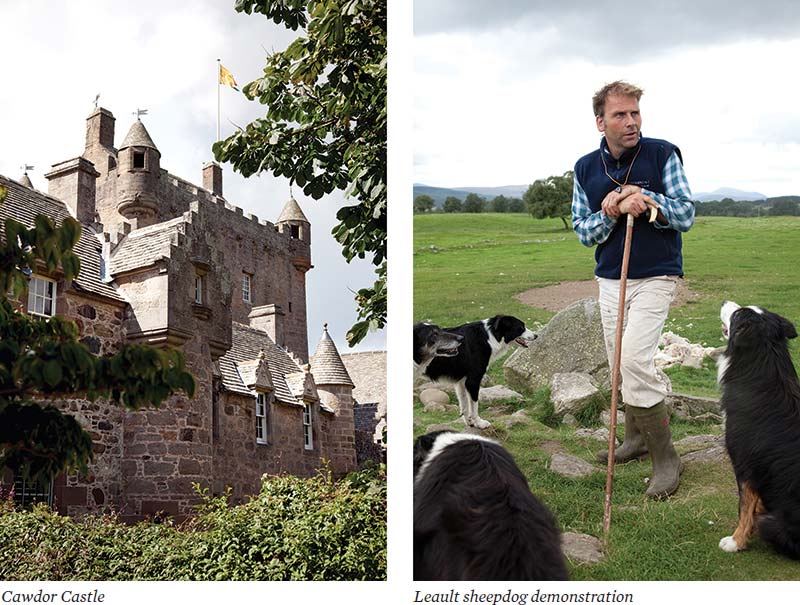
While you can find traditional folk music sessions in pubs and hotel bars anywhere in town, two places are well-established as the music pubs. Neither charges a cover for the music, unless a bigger-name band is playing.
The Gellions has live folk and Scottish music nightly from 21:30. It has local ales on tap and brags it’s the oldest bar in town (14 Bridge Street, tel. 01463/233-648, www.gellions.co.uk).
Hootananny is an energetic place with several floors of live rock, blues, or folk music, and drinking fun nightly. It’s rock (upstairs) and reel (ground floor). Music in the main bar (ground floor) usually begins about 21:30 (traditional music sessions Sun-Wed, trad bands on weekends; also a daytime session on Sat afternoon at 14:30). On Friday and Saturday nights only, upstairs is the Mad Hatter’s nightclub, complete with a cocktail bar (67 Church Street, tel. 01463/233-651, www.hootananny.co.uk).
SoBar is a sprawling pub with dartboards (free but £5 deposit), pool tables (£7.50 per hour), a museum worth of sports memorabilia, and the biggest TV screens in town (popular on big game nights). It’s a fine place to hang out and meet locals if you’d rather not have live music (just across from the castle at 55 Castle Street, tel. 01463/229-780).
For a whisky education, or just a fine cocktail, drop in to the intimate Malt Room, with whiskies ranging from £4 to £75. The whisky-plus-chocolate flight makes for a fun nightcap (just off Church Street in the alley leading to the Victorian Market, 34 Church Street, tel. 01463/221-888, Lee and Matt).
At the Black Isle Brewery, you can sample their local organic beers and ciders. Choose from 26 beers on tap (including some non-Black Isle brews), all listed on the TV screen over the bar (wood-fired pizzas, 68 Church Street, tel. 01463/229-920).
$$$ Café 1 serves up high-quality modern Scottish and international cuisine with trendy, chic bistro flair. Fresh meat from their own farm adds to an appealing menu (lunch and early-bird dinner specials until 18:45, open Mon-Fri 12:00-14:30 & 17:00-21:30, Sat from 13:00 & 18:00, closed Sun, reservations smart, 75 Castle Street, tel. 01463/226-200, www.cafe1.net).
$$ Number 27 has a straightforward, crowd-pleasing menu that offers something for everyone—burgers, pastas, and more. The food is surprisingly elegant for this price range (daily 12:00-15:00 & 17:00-21:00, generous portions, local ales on tap, 27 Castle Street, tel. 01463/241-999).
$$ La Tortilla has Spanish tapas, including spicy king prawns (the house specialty). It’s a colorfully tiled and vivacious dining option that feels like Spain. With the tapas format, three family-style dishes make about one meal (daily 12:00-22:00, 99 Castle Street, tel. 01463/709-809).
Rick’s Tip: To eat upscale on a budget, take advantage of early-bird specials at the finer restaurants.
$$$$ The Mustard Seed serves Scottish food with a modern twist in an old church with a river view. It’s a lively place with nice outdoor tables over the river when sunny (early specials before 19:00, daily 12:00-15:00 & 17:30-22:00, reservations smart, on the corner of Bank and Fraser Streets, 16 Fraser Street, tel. 01463/220-220, www.mustardseedrestaurant.co.uk, Matthew).
$$ Hootananny is a spacious pub with a hardwood-and-candlelight vibe and a fun menu featuring dishes one step above pub grub (food served Mon-Sat 12:00-15:00 & 17:00-20:30, dinner only on Sun). The kitchen closes early to make way for the live music scene that takes over each night after 21:30.
$$ Aspendos serves up freshly prepared, delicious Turkish dishes in a spacious, dressy, and exuberantly decorated dining room (daily 12:00-21:30, 26 Queensgate, tel. 01463/711-950).
Picnic: There’s a Co-op market with plenty of cheap picnic grub at 59 Church Street (daily until 22:00).
$$$$ Rocpool Restaurant is a hit with locals, good for a splurge, and perhaps the best place in town. Owner/chef Steven Devlin serves creative modern European food to a smart clientele in a sleek, contemporary dining room (early-bird weekday special until 18:45, open Mon-Sat 12:00-14:30 & 17:45-22:00, closed Sun, reservations essential; across Ness Bridge at 1 Ness Walk, tel. 01463/717-274, www.rocpoolrestaurant.com).
$$$$ River House, a classy, sophisticated, but unstuffy riverside place, is the brainchild of Cornishman Alfie—who prides himself on melding the seafood know-how of both Cornwall and Scotland, with a bit of Mediterranean flair (Mon-Sat 15:00-21:30, closed Mon off-season and Sun year-round, reservations smart, 1 Greig Street, tel. 01463/222-033, www.riverhouseinverness.co.uk).
$$$ The Kitchen Brasserie is a modern building overlooking the river, popular for their homemade comfort food—pizza, pasta, and burgers (early-bird special until 19:00, daily 12:00-15:00 & 17:00-22:00, 15 Huntly Street, tel. 01463/259-119, www.kitchenrestaurant.co.uk, Christine).
Fish-and-Chips: Consider the $ Catch of the Day chippy for a nicely presented sit-down meal or to go (daily 12:00-14:00 & 16:30-22:00, closed Sun at lunch, a block over Ness Bridge on Young Street, mobile 07909-966-525).
These B&Bs are popular; book ahead for June through August (and during the peak times listed in “Helpful Hints,” earlier), and be aware that some require a two-night minimum during busy times. The places I list are a 10- to 15-minute walk from the train station and town center. To get to the B&Bs, either catch a taxi (£5) or walk: From the train and bus stations, go left on Academy Street. At the first stoplight (the second if you’re coming from the bus station), veer right onto Inglis Street in the pedestrian zone. Go up the Market Brae steps. At the top, turn right onto Ardconnel Street.
$$ Ardconnel House is a classic, traditional place offering a nice, large guest lounge, along with six spacious and comfortable rooms (family room, 2-night minimum preferred in summer, no children under 10, 21 Ardconnel Street, tel. 01463/240-455, www.ardconnel-inverness.co.uk, ardconnel@gmail.com, John and Elizabeth).
$ Craigside Lodge B&B has five large rooms with tasteful modern flair, nice tartan touches, and fun stuffed-animal doorstoppers. The breakfast room is a nice place to soak up city views (family room, no kids under 8, just above Castle Street at 4 Gordon Terrace, tel. 01463/231-576, www.craigsideguesthouse.co.uk, enquiries@craigsideguesthouse.co.uk, hospitable Paul and Mandy).
$ Crown Hotel Guest House has seven pleasant rooms (two with private bath down the hall) and is a bargain if you’re willing to put up with a few quirks—some dated elements and owners who are still learning the ins and outs of running a guesthouse (family room, 19 Ardconnel Street, tel. 01463/231-135, www.crownhotel-inverness.co.uk, crownhotelguesthouse@gmail.com, Munawar and Asia).
$$ Eildon Guesthouse, set on a quiet corner, offers five tranquil rooms with spacious baths. The cute-as-a-button 1890s countryside brick home exudes warmth and serenity from the moment you open the gate (family rooms, 2-night minimum in summer, no kids under 10, in-room fridges, parking, 29 Old Edinburgh Road, tel. 01463/231-969, www.eildonguesthouse.co.uk, eildonguesthouse@yahoo.co.uk, Jacqueline).
$$ Dionard Guest House, wrapped in a fine hedged-in garden, has cheerful common spaces, six lovely rooms, and lively hosts Gail and Anne—best friends turned business partners (family suite, in-room fridges, they’ll do guest laundry for free, 39 Old Edinburgh Road, tel. 01463/233-557, www.dionardguesthouse.co.uk, enquiries@dionardguesthouse.co.uk).
$$ Lynver Guest House will make you feel spoiled, with three large, boutiquey rooms (all with sitting areas), a backyard stone patio that catches the sun, and veggie and fish options at breakfast (2-night minimum preferred in summer, no kids under 10, in-room fridges, 30 Southside Road, tel. 01463/242-906, www.lynver.co.uk, info@lynver.co.uk, Michelle and Brian).
$$ Rossmount Guest House feels like home, with its curl-up-on-the-couch lounge space, unfussy rooms (five in all), and friendly hosts (two rooms share a bath and are cheaper, 2-night minimum in summer, Argyle Street, tel. 01463/229-749, www.rossmount.co.uk, mail@rossmount.co.uk, Ruth and Robert).
$$$ Strathness House has a prime spot on the river a block from Ness Bridge. Formerly a hotel, it’s a bigger place, with 12 rooms and a large ground-floor lounge, but comes with the same intimate touches of a guesthouse. They cater to all diets at breakfast (family room for 3, no kids under 5, street or off-site parking, 4 Ardross Terrace, tel. 01463/232-765, www.strathnesshouse.co.uk, info@strathnesshouse.com, Joan and Javed).
$$ Castle View Guest House sits right along the River Ness at the Ness Bridge—and, true to its name, it owns smashing views of the castle. Its five big and comfy rooms (some with views) are colorfully furnished, and the delightful place is lovingly run by Eleanor (2A Ness Walk, tel. 01463/241-443, www.castleviewguesthouseinverness.com, enquiries@castleviewguesthouseinverness.com).
Inverness has a number of big chain hotels. These tend to charge a lot but may be worth a look if the B&Bs are full or if it’s outside the main tourist season. Options include the Inverness Palace Hotel & Spa (a Best Western fancy splurge right on the river with a pool and gym), Premier Inn (River Ness location), and Mercure. The following hotels are smaller and more local.
$$$ Heathmount Hotel’s understated facade hides a chic retreat for comfort-seeking travelers. Its eight elegant rooms come with unique decoration, parking, and fancy extras (family room, no elevator, restaurant, Kingsmill Road, tel. 01463/235-877, www.heathmounthotel.com, info@heathounthotel.com,).
$$$ Waterside Inverness, in a nice, peaceful location along the River Ness, has 35 crisp rooms and a riverview restaurant (parking, 19 Ness Bank, tel. 01463/233-065, www.thewatersideinverness.co.uk, info@thewatersideinverness.co.uk).
¢ Bazpackers Hostel, a stone’s throw from the castle, has a quiet, private feel for a hostel. There are 34 beds in basic dorms (private rooms with shared bath available, reception open 7:30-23:00, no curfew, pay laundry service, 4 Culduthel Road, tel. 01463/717-663, www.bazpackershostel.co.uk, info@bazpackershostel.co.uk). They also rent a small apartment nearby (sleeps up to 4).
¢ Inverness Student Hotel has 57 thin-mattressed beds in nine brightly colored rooms and a laid-back lounge overlooking the River Ness. The knowledgeable, friendly staff welcomes any traveler over 18 (breakfast extra, free tea and coffee, pay laundry service, kitchen, 8 Culduthel Road, tel. 01463/236-556, www.invernessstudenthotel.com, info@invernessstudenthotel.com).
With a car, the day trips around Inverness are easy. Without a car, side-trip to Loch Ness, Culloden, and other nearby sights by public bus or with a bus tour.
Trains are generally best for connecting Inverness with Edinburgh, Stirling, Glasgow, and Pitlochry. Buses work well for connections with the Isle of Skye, Oban, and Glencoe.
The train station, two blocks from the bus station, is centrally located on Academy Street, several blocks east of the River Ness.
From Inverness by Train to: Pitlochry (hourly, 1.5 hours), Stirling (every 1-2 hours, 3 hours, some transfer in Perth), Kyle of Lochalsh near Isle of Skye (4/day, 2.5 hours), Edinburgh (hourly, 4 hours, some with change in Perth), Glasgow (11/day, 3 hours, 4 direct, others change in Perth). The Caledonian Sleeper provides overnight service to London (www.sleeper.scot). Train info: tel. 0345-748-4950, www.nationalrail.co.uk.
The bus station is on Margaret Street, near the train station. Tickets are sold in advance online, by phone (tel. 0871-266-3333), or in person at the station (daily 7:45-18:15, baggage storage, tel. 01463/233-371).
Inverness has a handy direct bus to Portree on the Isle of Skye (bus #917, 3/day, 3 hours), but for other destinations in western Scotland, you’ll first head for Fort William (bus #19 or #919, 8/day, 2 hours), then transfer to bus #918 for Oban (figure 4 hours total from Inverness) or Glencoe (bus stops at nearby Ballachulish; figure 3 hours total).
Inverness is also connected by direct bus to Edinburgh (express bus #G90, 2/day, 3.5 hours; slower bus #M90, 6/day, 4 hours) and Glasgow (5/day on Citylink express bus #G10, 3 hours; 1/day direct on National Express #588, 4 hours). Scottish Citylink: www.citylink.co.uk.
For bus travel to England, check National Express (www.nationalexpress.com) or Megabus (http://uk.megabus.com).
Inverness to Edinburgh (160 miles, 3.25 hours minimum): Leaving Inverness, follow signs to the A-9 (south, toward Perth). If you haven’t seen the Culloden Battlefield yet, it’s an easy detour: Just as you leave Inverness, head four miles east off the A-9 on the B-9006. Back on the A-9, it’s a wonderfully speedy, scenic highway (A-9, M-90, A-90) all the way to Edinburgh. If you have time, consider stopping en route in Pitlochry (just off the A-9).
Inverness to Portree, Isle of Skye (110 miles, 2.5 hours): The drive from Inverness to Skye is pretty, but much less so than the valley of Glencoe or the Isle of Skye itself. You’ll drive along boring Loch Ness and then follow signs to Portree and Skye on A-87 along Loch Cluanie.
Inverness to Fort William (65 miles, 1.5 hours): This city, southwest of Inverness via the A-82, is a good gateway to Oban and Glencoe.
I’ll admit it: I had my zoom lens out and my eyes on the water. The local tourist industry thrives on the legend of the Loch Ness monster. It’s a thrilling thought, and there have been several seemingly reliable “sightings” (by monks, police officers, and sonar imaging). But even if you ignore the monster stories, the loch is impressive: 23 miles long, less than a mile wide, 754 feet deep, and containing more water than all of the freshwater bodies of England and Wales combined. It’s essentially the vast chasm of a fault line, filled with water.
Getting There: The Loch Ness sights are a 20-minute drive southwest of Inverness. To drive the full length of Loch Ness takes about 45 minutes. Fort William-bound buses #19 and #919 make stops at Urquhart Castle and Drumnadrochit (8/day, 40 minutes).
▲LOCH NESS CENTRE & EXHIBITION
In July 1933, a couple swore they saw a giant sea monster shimmy across the road in front of their car by Loch Ness. Within days, ancient legends about giant monsters in the lake (dating as far back as the sixth century) were revived—and suddenly everyone was spotting “Nessie” poke its head above the waters of Loch Ness. Further sightings and photographic “evidence” have bolstered the claim that there’s something mysterious living in this unthinkably deep and murky lake. (Most sightings take place in the deepest part of the loch, near Urquhart Castle.) Most witnesses describe a waterbound dinosaur (resembling the real, but extinct, plesiosaur). Others cling to the slightly more plausible theory of a gigantic eel. And skeptics figure the sightings can be explained by a combination of reflections, boat wakes, and mass hysteria. The most famous photo of the beast (dubbed the “Surgeon’s Photo”) was later discredited—the “monster’s” head was actually attached to a toy submarine. But that hasn’t stopped various cryptozoologists from seeking photographic, sonar, and other proof.
And that suits the thriving local tourist industry just fine. The Nessie commercialization is so tacky that there are two different monster exhibits within 100 yards of each other, both in the town of Drumnadrochit. Of the two competing sites, Nessieland is pretty cheesy while the Loch Ness Centre and Exhibition (described later) is surprisingly thoughtful. Each has a tour-bus parking lot and more square footage devoted to their kitschy shops than to the exhibits. While Nessieland is a tourist trap, the Loch Ness Centre may appease that small part of you that knows the real reason you wanted to see Loch Ness.
This exhibit has two parts: First you make six stops in a series of video rooms, and then you enter the exhibition explaining the history of the Great Glen and Loch Ness. It’s spearheaded by Adrian Shine, a naturalist who has spent many years researching lake ecology and scientific phenomena. With video presentations and special effects, this exhibit explains the geological and historical environment that bred the monster story, as well as the various searches that have been conducted. Refreshingly, it retains an air of healthy skepticism instead of breathless monster-chasing. It also has some artifacts related to the search, such as a hippo-foot ashtray used to fake monster footprints and the Viperfish—a harpoon-equipped submarine used in a 1969 Nessie search.

Loch Ness Centre
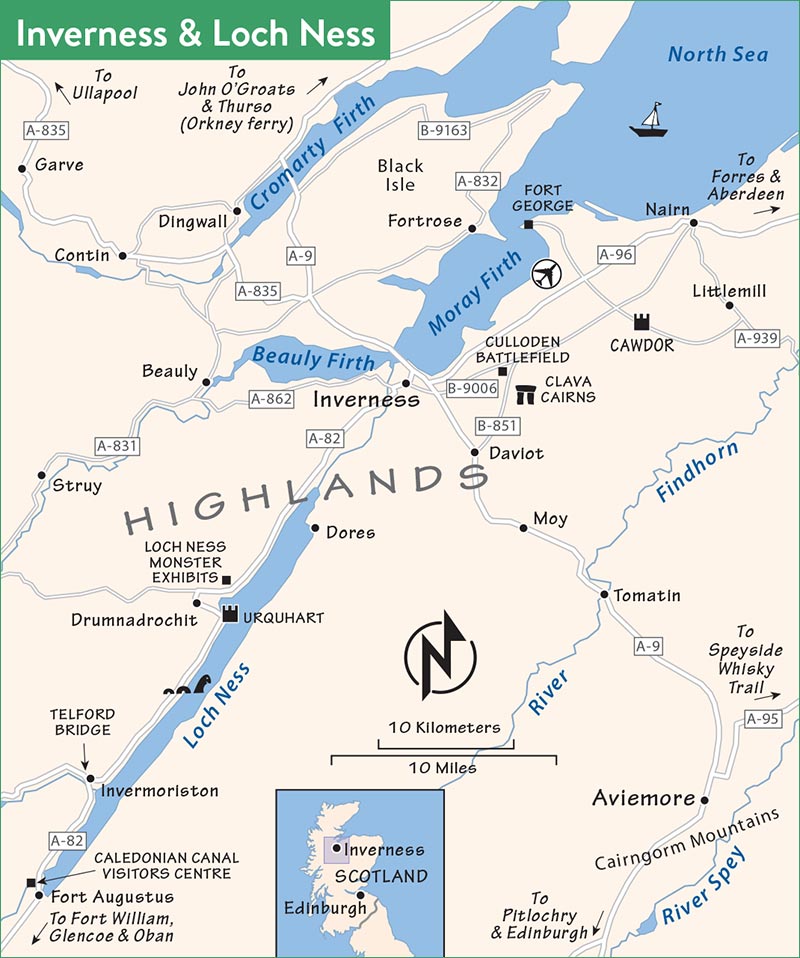
Cost and Hours: £8, ask about RS%, daily Easter-Oct 9:30-17:45, July-Aug until 18:45, Nov-Easter 10:00-16:15, last entry 45 minutes before closing, in the big stone mansion right on the main road to Inverness, tel. 01456/450-573, www.lochness.com.
The ruins at Urquhart (UR-kurt), just up the loch from the Nessie exhibits, are gloriously situated with a view of virtually the entire lake and create a traffic jam of tourism on busy days.
The visitors center has a tiny exhibit with interesting castle artifacts and an eight-minute film taking you on a sweep through a thousand years of tumultuous history—from St. Columba’s visit to the castle’s final destruction in 1689. The castle itself, while dramatically situated and fun to climb through, is an empty shell. After its owners (who supported the crown) blew it up to keep the Jacobites from taking it, the largest medieval castle in Scotland (and the most important in the Highlands) wasn’t considered worth rebuilding or defending, and was abandoned. Well-placed, descriptive signs help you piece together this once-mighty fortress. As you walk toward the ruins, take a close look at the trebuchet (a working replica of one of the most destructive weapons of English King Edward I), and ponder how this giant catapult helped Edward grab almost every castle in the country away from the native Scots.
Cost and Hours: £9, guidebook-£5, daily April-Sept 9:30-18:00, Oct until 17:00, Nov-March until 16:30, last entry 45 minutes before closing, café, tel. 01456/450-551, www.historic-scotland.gov.uk).
Rick’s Tip: Cruises on Loch Ness are as popular as they are pointless. The lake is scenic, but far from Scotland’s prettiest—and the time-consuming boat trips show you little more than what you’ll see from the road. I’d rather spend my time and money at Fort Augustus or Urquhart Castle.
Perhaps the most idyllic stop along the Caledonian Canal is the little lochside town of Fort Augustus. It makes a delightful stop if you’re driving through the area. Parking is easy. There are plenty of B&Bs, charming eateries, and an inviting park along the town’s five locks. You can still see the capstans, surviving from the days when the locks were cranked open by hand.
The fine little Caledonian Canal Visitor Centre tells the story of the canal’s construction (free, daily Easter-Oct, tel. 01320/366-493). Also, consider the pleasant little canalside stroll out to the head of the loch.
Eating in Fort Augustus: You can eat reasonably at a string of eateries all lining the same side of the canal. Consider The Little Neuk, a good café serving filled rolls and homemade soups; The Lock Inn, cozy and pub-like with great canalside tables, ideal if it’s sunny; The Bothy, another pub with decent food; and the Canalside Chip Shop offering fish-and-chips to go (no seating, but plenty of nice spots on the canal). A small grocery store is at the gas station, next to the TI, which is a few steps from the canal just after crossing the River Oich (also housing the post office, a WC, and an ATM).
The town of Pitlochry, on the edge of Cairngorms National Park, has a green-hills-and-sandstone charm, a warm welcome, and a pair of great distilleries linked by a nice hike. Nearby you’ll find a fascinating trip back to prehistory, at the Scottish Crannog Centre on Loch Tay.
At the east end of the Cairngorms, requiring more of a detour, is Balmoral Castle, Queen Elizabeth’s country retreat.
This likable tourist town, famous for its whisky and its hillwalking (both beloved by Scots), makes an enjoyable stop. Just outside the craggy Highlands, Pitlochry is set amid pastoral rolling hills that offer plenty of forest hikes. It seems that tourism is the town’s only industry—with perhaps Scotland’s highest concentration of woolens shops and outdoor outfitters.
Plucky little Pitlochry (pop. 2,500) lines up along its tidy, tourist-minded main street, Atholl Road, which runs parallel to the River Tummel. Its two distilleries are a walk—or short drive—out of town (see my self-guided whisky walk). Navigate by following the black directional signs to Pitlochry’s handful of sights.
Getting There: Pitlochry is linked by train with Inverness (almost hourly, 2 hours), Edinburgh (8/day direct, 2 hours), and Glasgow (9/day, 2 hours). For drivers, it’s right off the A-9 highway connecting Inverness, Stirling, and Edinburgh.
Arrival in Pitlochry: The train station is on Station Road, off the main street. Drivers can park in the large pay-and-display lot next to the TI, in the center of town.
Tourist Information: The helpful TI, at one end of town, sells maps for local hill walks and scenic drives. Their good Pitlochry Path Network brochure is handy (Mon-Sat 9:30-17:30, Sun 10:00-16:00, longer hours in summer, shorter hours and closed Sun Nov-March; 22 Atholl Road, tel. 01796/472-215).

Pitlochry
Rick’s Tip: Pitlochry’s Highland Games are in early September (www.pitlochryhighlandgames.co.uk).
Pitlochry’s two distilleries can be linked by a relaxing two-hour hike (described below).
This cute distillery (pronounced ED-rah-dower)—the smallest historic distillery in Scotland (est. 1825)—takes pride in making its whisky with a minimum of machinery, and maintains a proud emphasis on tradition. Small white-and-red buildings are nestled in a delightfully green Scottish hillside. (“Edradour”—also the name of the stream that gurgles through the complex—means “land between two rivers.”) With its idyllic setting and gregarious spirit, it’s one of the most enjoyable distillery tours in Scotland. If you like the whisky, buy some here and support the Pitlochry economy—this is one of the few independently owned distilleries left in Scotland.
Cost and Hours: £7.50 for a one-hour tour, departs 3/hour, April-Oct Mon-Sat 10:00-17:00, closed Sun and off-season, last tour departs one hour before closing, tel. 01796/472-095, www.edradour.com.
Getting There: If coming to the distillery by car, follow signs from the main road, 2.5 miles into the countryside.
This big, ivy-covered facility is conveniently located (about a half-mile from the town center) and more corporate-feeling, offering hour-long tours with a wee taste at the end. I’d tour this only if you’re a whisky completist, or if you lack the wheels or hiking stamina to reach Edradour.
Cost and Hours: £7.50, Easter-Oct tours depart 2/hour daily 10:00-17:00, July-Aug until 17:30, last tour departs one hour before closing; shorter hours, fewer tours, and closed Sat-Sun off-season; tel. 01796/482-003, www.discovering-distilleries.com/blairathol.
A fun way to visit the distilleries is to hillwalk from downtown Pitlochry. The entire loop trip takes 2-3 hours, depending on how long you linger in the distilleries (at least an hour of walking each way). You’ll see lush fern forests and a pretty decent waterfall. The walk is largely uphill on the way to the Edradour Distillery; wear good shoes, bring a rain jacket just in case, and be happy that you’ll stroll easily downhill after you’ve had your whisky samples.
At the TI, pick up the Pitlochry Path Network brochure and follow along with its map. You’ll be taking the Edradour Walk (marked on directional signs with yellow hiker icons; on the map it’s a series of yellow dots). Leave the TI and head left along the busy A-924. The walk can be done in either direction, but I’ll describe it counterclockwise.
Within 10 minutes, you’ll walk under the railroad tracks and then come to Bell’s Blair Athol Distillery on your left. If you’re a whisky buff, stop in here. Otherwise, hold out for the much more atmospheric Edradour. You’ll pass a few B&Bs and suburban homes, then a sign marked Black Spout on a lamppost. Just after this, you’ll cross a bridge, then take the next left, walking under another stone rail overpass and away from the road. Following this path, you’ll come to a clearing, and as the road gets steeper, you’ll see signs directing you 50 yards off the main path to see the “Black Spout”—a wonderful waterfall well worth the few extra steps on your right.
At the top of the hill, you’ll arrive in another clearing, where a narrow path hugs a huge field on your left. Low rolling hills surround you in all directions. From here it’s an easy 20 minutes to the Edradour Distillery.
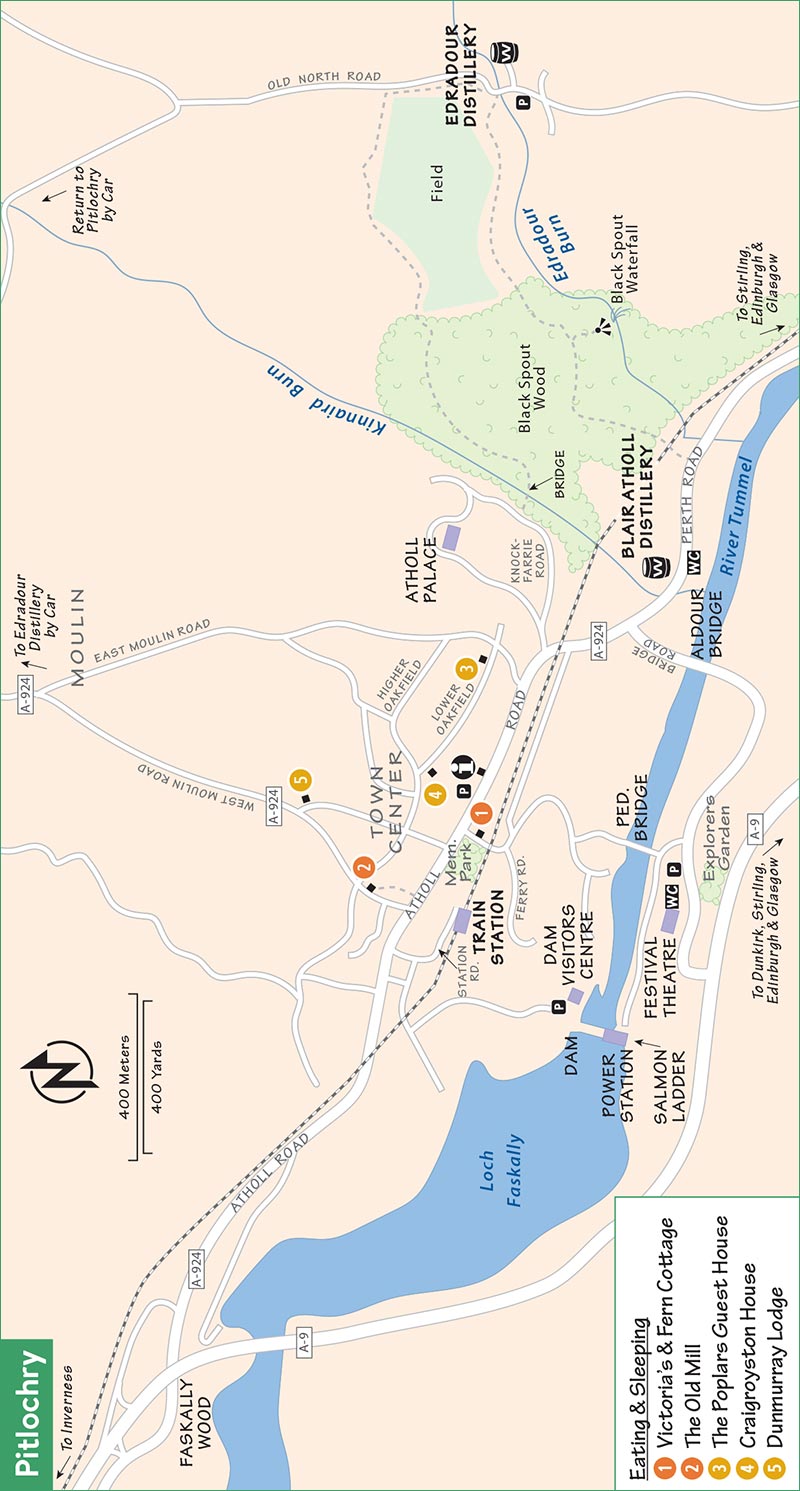
Leaving the distillery, to complete the loop, head right, following the paved road (Old North Road). In about 50 yards, a sign points left into the field. Take the small footpath that runs along the left side of the road. (If you see the driveway with stone lions on both sides, you’ve gone a few steps too far.) You’ll walk parallel to the route you took getting to the distillery, hugging the far side of the same huge field. The trail then swoops back downhill through the forest, until you cross the footbridge and make a left. You’ll soon reach Knockfarrie Road—take this downhill; you’ll pass a B&B and hear traffic noises as you emerge from the forest. The trail leads back to the highway, with the TI a few blocks ahead on the right.
Across Scotland, archaeologists know that little round islands on the lochs are evidence of crannogs—circular houses on stilts, dating to 500 years before Christ. Iron-Age Scots built on the water because in an age before roads, people traveled by boat, and because waterways were easily defended against rampaging animals (or people). Scientists have found evidence of 18 such crannogs on Loch Tay alone. One has been rebuilt, using mostly traditional methods, and now welcomes visitors. Guided by a passionate and well-versed expert, you’ll spend about an hour visiting the crannog and learning about how its residents lived.
Cost and Hours: £10, family tickets available, daily 10:00-17:30, closed Nov-March, about 40 minutes outside Pitlochry, well-marked just outside the town of Kenmore on the south bank of Loch Tay, tel. 01887/830-583, www.crannog.co.uk.
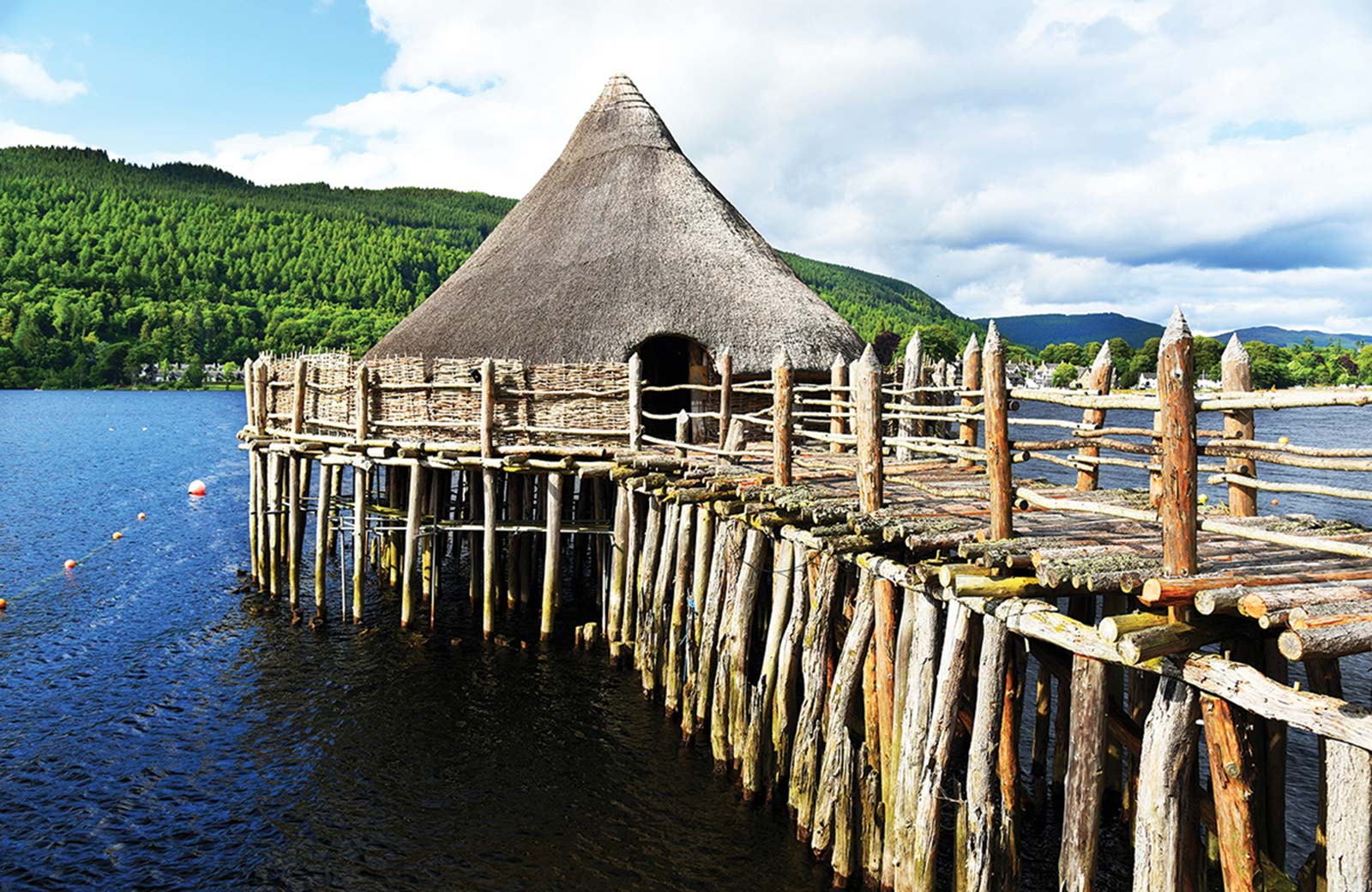
Rebuilt hut at Scottish Crannog Centre
$$ Victoria’s restaurant and coffee shop is a local favorite (daily, 45 Atholl Road). $$$ The Old Mill, tucked a block behind the main drag, has good Scottish food (daily). $$$ Fern Cottage, just behind Victoria’s, has a dressier ambience (daily, Ferry Road).
Overnighters can choose from $$ The Poplars Guest House, perched regally on a meticulously landscaped hill high above the main road (at the end of Lower Oakfield at #27, www.poplars-pitlochry.com); $$ Craigroyston House, my sentimental favorite in Pitlochry (2 Lower Oakfield, www.craigroyston.co.uk); or $$ Dunmurray Lodge, a calming place to call home (72 Bonnethill Road, www.dunmurray.co.uk).
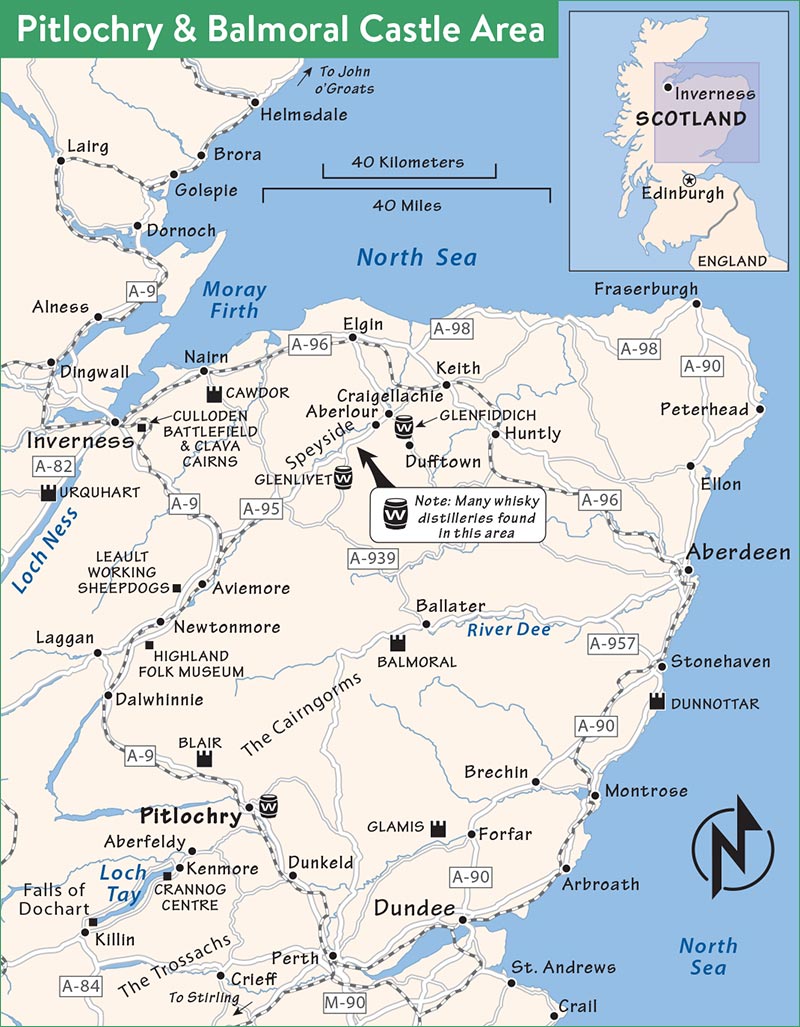
The Scottish home of the British royal family is wrapped in some of the most gorgeous scenery of Cairngorms National Park, in the forested valley of the River Dee. The Queen stays at her 50,000-acre private estate from August through early October. But in the months leading up to Her Majesty’s arrival, the grounds and the castle’s ballroom are open to visitors.
Queen Victoria and Prince Albert purchased Balmoral in 1848. Ever since, each British monarch has enjoyed retreating to this sprawling property, designed for hunting (red deer) and fishing (salmon). Today Balmoral has a huge staff, 80 miles of roads, a herd of Highland cattle, and a flock of Highland ponies, stout miniature horses useful for hauling deer carcasses over the hills.
Day Plan: You’ll need about 1.5 hours to tour the grounds and gardens. You can have lunch on the grounds or in the nearby village of Ballater.

Balmoral Castle
Getting There: Balmoral is located on the east side of Cairngorms National Park, just off the A93 near Ballater.
Cost and Hours: £11.50, includes audioguide, April-July daily 10:00-17:00, closed Aug-March, arrive at least an hour before closing.
Information: Tel. 013397/42534, www.balmoralcastle.com.
Rick’s Tip: If you’re caught up in the beauty of Balmoral, consider booking a ranger-led Land Rover safari through the grounds (£60, 3 hours, 2/day during the open season).
 Visiting the Castle
Visiting the CastleFrom the parking lot (with a TI/gift shop, WCs, and the royal church across the street), walk across the River Dee to reach the ticket booth. From here, you can either hike 10 minutes to the palace, or hop on the free trolley.
Once at the stables, pick up your included audioguide and peruse a few exhibits, including an 8-minute orientation film. Peek into the Queen’s garage to see her custom Bentley.
Then follow your audioguide on a short loop through the grounds and gardens before arriving at the palace. (To cut to the chase, or if the weather is bad, you can shortcut from the exhibit directly to the palace and the one room open to the public.) As you walk through the produce and flower gardens, ponder the unenviable challenge of trying to time all of the flowers to bloom and the produce to ripen at the same time, coinciding with the royal family’s arrival in the first week of August (especially difficult given Scotland’s notoriously uncooperative climate).
Finally you’ll reach the single room in the palace open to the public: the palace ballroom. Display cases show off memorabilia (children’s games played by royal tots, and a fully operational mini-Citroën that future kings and queens have enjoyed driving around). Near the exit, a touchscreen offers you a virtual glimpse at the tartaned private quarters that are off-limits to us commoners.
Nearby: For a free peek at another royal landmark, stop at Crathie Kirk, the small, stony, charming parish church where the royal family worships when they are at Balmoral, and where Queen Victoria’s beloved servant John Brown is buried. The church is just across the highway from the Balmoral parking lot.